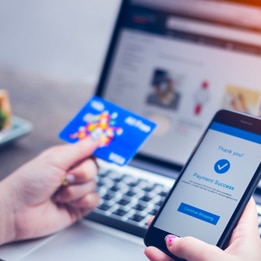
According to a survey conducted by MarkMonitor in 2017, roughly 1 in 4 online shoppers reported that they had been tricked into buying a fake or bad-quality item. Of these sales, 39% of fake products came from online marketplaces such as Amazon and eBay. Even though there are rules and regulations set in place by these marketplaces, scam artists keep finding new ways to bypass the system to sell their poorly-made items.
Customers and online merchants are both negatively affected by these illegitimate sellers, leaving them with numerous doubts and questions. For instance, what does this rise in fake sellers mean for legitimate eCommerce retailers? How can shoppers determine whether a product listing is fake or high-quality? What can business leaders do to ensure customer trust and satisfaction?
To fully understand the hazardous effects that misleading customers can have, it’s helpful to know why counterfeit products have become so prevalent online in recent years. After learning the history of these scams, then you can create a more trustworthy site for your business and begin to recognize and avoid scams yourself.
The Rise of Counterfeit Products
Around 2008, the influx of foreign packages containing counterfeit products started to overwhelm the resources of the U.S. Customs Patrol and Border Control. Many items from independent retailers on popular eCommerce marketplaces were fake or low-quality. These products included all sorts of fake merchandise, such as clothing, pet supplies, health supplements, cosmetics, and more.
Since thousands of these eCommerce orders were placed by unassuming online shoppers, these scam artists began to send the products in smaller packages via the postal service or by using home delivery companies. This stretched the limited resources of the U.S. Border Control even further, which allowed the fake products to bypass the quality checks undetected and arrive in the hands of American customers.
For over a decade now, these scams have been ongoing, and they continue to pop up everywhere on the internet. Retailers who sell fake products may pay for ad space on social media platforms, even going so far as to steal real advertisements from legitimate companies, in order to appear like trustworthy businesses to customers. They might even set up entire websites in an effort to swindle customers who are just looking for a great deal online.
Warning Signs of Online Scams
As illegitimate third-party sellers become savvier and bolder in their schemes, online shoppers have to learn how to avoid and report these fake brands. Melissa Trumpower, the Director of Programs and Operations at the BBB Institute for Marketplace Trust, states that, “Most online shopping scams are essentially ordering a product and never receiving the product, so you’ve paid money and you’ve received nothing in return,” whereas other scams will steal shopper’s financial information or simply send them cheap or broken items.
As a general rule, all customers should refrain from buying products that seem too good to be true. For instance, scam artists may post a photo of a high-quality clothing item and list it for an extremely low price, or claim that customers can purchase a brand-new product at less than half of what the item sells for in-store. Fake retailers might have hoops customers need to go through in order to obtain these deals, like requiring immediate payment with vouchers or insisting that customers use a specific money-wiring service.
Along with the “too good to be true” rule, online customers should also be wary about other signs of potential scams. These may include:
- New shops on social media platforms. Anyone can create a page on Facebook and quickly create a professional-looking store. These online pop-up stores typically have products listed for very low amounts and give customers limited information about delivery, where the seller is from, return policies, or other business information.
- Spelling/grammar errors on the website. A product description riddled with poor grammar and spelling is a sign that the seller is from a different country than what their website might claim. In addition, most professional business leaders take pride in maintaining a high-quality website and will be quick to fix any of these mistakes.
- Suspicious reviews. Melissa Trumpower warns shoppers, “If there’s all positive feedback and nothing negative [on an eCommerce site], that may be a red flag.” Consumers should be cautious of products that have very few reviews, all 5-star reviews, or reviews that seem to be written in very similar styles.
- Missing information. Legitimate businesses will have clear return policies, email addresses featuring the brand or company domain name, and shipping information. If information is difficult to understand or completely missing from the site, consumers should not trust the website.
- Strange pop-ups or emails. The Federal Trade Commission says that if a customer ever gets an email or pop-up from a seller asking for their credit card number or other financial information, they should immediately leave the site and/or delete the email. The FTC states that, “Legitimate companies don’t ask for information that way.”
For a deeper dive into the specific things customers should keep their eyes peeled for, check out this 2021 red flags for shoppers guide.
Counterfeit Products and Effects on Consumers
Steve Bernas, president and CEO of the Better Business Bureau in Chicago and Northern Illinois, urges shoppers to avoid purchasing items that don’t come from trusted brands and websites. Bernas says, “Please don’t buy fake counterfeit products…you’re hurting the economy, you’re hurting all of us and you may be hurting yourself.”
Some shoppers fail to recognize how risky it can be when they buy cheap replicas from third-party sellers. One woman was charged $86 instead of $75 for an item she purchased on an unfamiliar website, and the company refused to refund the money—even after she received the wrong product. U.S. Border and Customs Protection agents also report that many counterfeit products can pose health and safety risks for consumers, especially fake cosmetic products and electronic devices. In one disturbing case, the Los Angeles police department uncovered a counterfeit cosmetics line that contained high levels of bacteria and animal waste. But that’s just the beginning.
According to researchers from Incopro, 32% of people who purchased at least one counterfeit item developed a health problem as a result. Notable examples of harmful counterfeit products can be found in a variety of different industries:
- Fake e-cigarettes have melted, started on fire, and even exploded, causing unaware buyers to endure severe burns and injuries.
- Counterfeit phone chargers were tested back in 2016, and 99% of them failed one of two basic safety checks. Failing either of these safety tests puts these chargers at a high risk for starting fires or giving users nasty electrical shocks.
- Cheap bicycle helmets were reported to be so fragile that they broke after a single low-impact bump. Meanwhile, the real helmets that the counterfeiters copied were able to withstand hard blows with no issues.
- Counterfeit pharmaceutical products have been sold online, and the FDA warns that these medicinal items might contain harmful substances, wrong ingredients, or no active ingredients at all.
The Department of Homeland Security warns buyers that purchasing counterfeit items is illegal, since this practice harms American businesses and supports criminal activities in other countries. People who are caught buying these kinds of products may face civil or criminal penalties, according to the CBP website.
How Fake Sellers Affect Professional eCommerce Sellers
Thousands of people around the world decide to purchase items online everyday after comparing prices, retailers, shipping fees, and return policies, but many continue to fall for the unbelievably low prices offered by fake merchants. In other cases, scam artists create online stores that seem nearly identical to a common brand in order to trick customers. One example of this occurred in 2017 when Pandorapick.com caught the attention of the Better Business Bureau after selling cheap replicas of jewelry from the legitimate site, Pandora.net. Pandorapick.com lured in customers of the popular jewelry brand by promising 75% off on charms, bracelets, earrings, and other items.
Business leaders posted on Pandora.net that, “Pandora will continue to fight those who attempt to abuse our name and brand to sell counterfeit products and deceive our customers, and our Brand Protection team maintains the highest standards of brand protection.” But even though the official Pandora company didn’t sell any counterfeit products or have any previous knowledge of Pandorapick.com, the jewelry brand still had to face increasing customer suspicion and wariness. Luckily, Pandora was able to regain customer trust and re-establish its name; but smaller eCommerce sellers may not be so fortunate:
- Entrepreneur Tannia Ospinia started a children’s clothing company called Belle Threads and posted photos of her young daughter modeling the pieces online. Ospinia was appalled after she found her photos on websites like AliExpress, where they were selling knock-offs of her products for heavily discounted prices. There was nothing she could do to prevent these cheap replicas from being sold, and she was unable to prevent the harm it caused to her company’s reputation.
- Small business owner Mariana Toscas claims that she has been fighting counterfeit websites since she opened her online shop in 2015. Toscas was initially successful with her unique clothing designs and slogans, but she quickly grew frustrated with online sellers stealing her photos and ideas. She explained to reporters, “I swear to God every day I wake up and there’s a new site selling my design…it’s literally like trying to stop an infestation.”
- Inventors of the Brush Hero, Kevin Williams and Glenn Archer, faced the difficult situation of being undersold by counterfeit sellers on Amazon. Their product gained hundreds of negative reviews because of the cheaply copied items from as many as five different retailers. The fake Brush Hero sellers even copied the original brand’s packaging, instructions, and photos to deceive consumers.
The Future of eCommerce
John Reilly, Daymon Senior Director of Global Quality Assurance, says “…there is no doubt that a counterfeit item can cause serious damage to a brand’s equity. Consumers who have purchased a product that turns out to be fake may blame the brand owner, which obviously results in a loss of sales. It can also seriously damage trust and goodwill. Just as important as the loss of trust and equity, the economic repercussions of removing the counterfeit product from stores and the supply chain are enormous.”
According to the Global Brand Counterfeiting Report, sales of counterfeit items are growing at 15% each year, and they are on track to reach $1.82 trillion by 2020. If online marketplaces continue to allow counterfeit businesses to advertise their low-quality items, these sellers will continue to prosper while high-quality brands decline.
To protect your own business from counterfeit sellers, you will have to go the extra mile to convince your customers that your brand is trustworthy. You can do so by:
- Creating a transparent distribution system for your products.
- Selling your products through an authorized retailer and making it clear that any other sellers are not affiliated with your brand.
- Filing complaints on online marketplaces if you receive a counterfeit item instead of the true product that was advertised.
- Providing excellent customer service to handle questions, returns, and refunds.
- Being active across all social media platforms: this will prevent counterfeiters from creating fake seller’s pages using your business information. You can also ask your loyal customers to report any suspicious advertisements they notice on sites like Amazon, eBay, or other marketplaces.
- Putting a strong emphasis on product quality.
Although suppressing counterfeit sellers for good is unlikely, you can maintain your brand’s credibility by taking the right steps to protect your unique products and ideas. Along with maintaining your high-quality business reputation and being savvy about your own online shopping habits, checking out the latest technologies available from Magento can ensure that your website will stay safe, reliable, and secure.
















